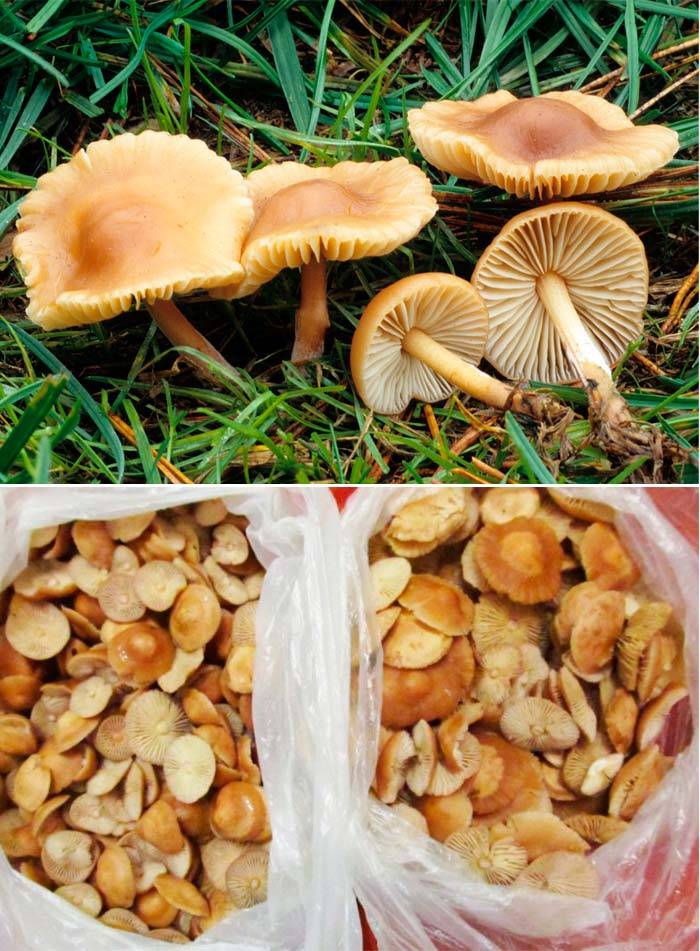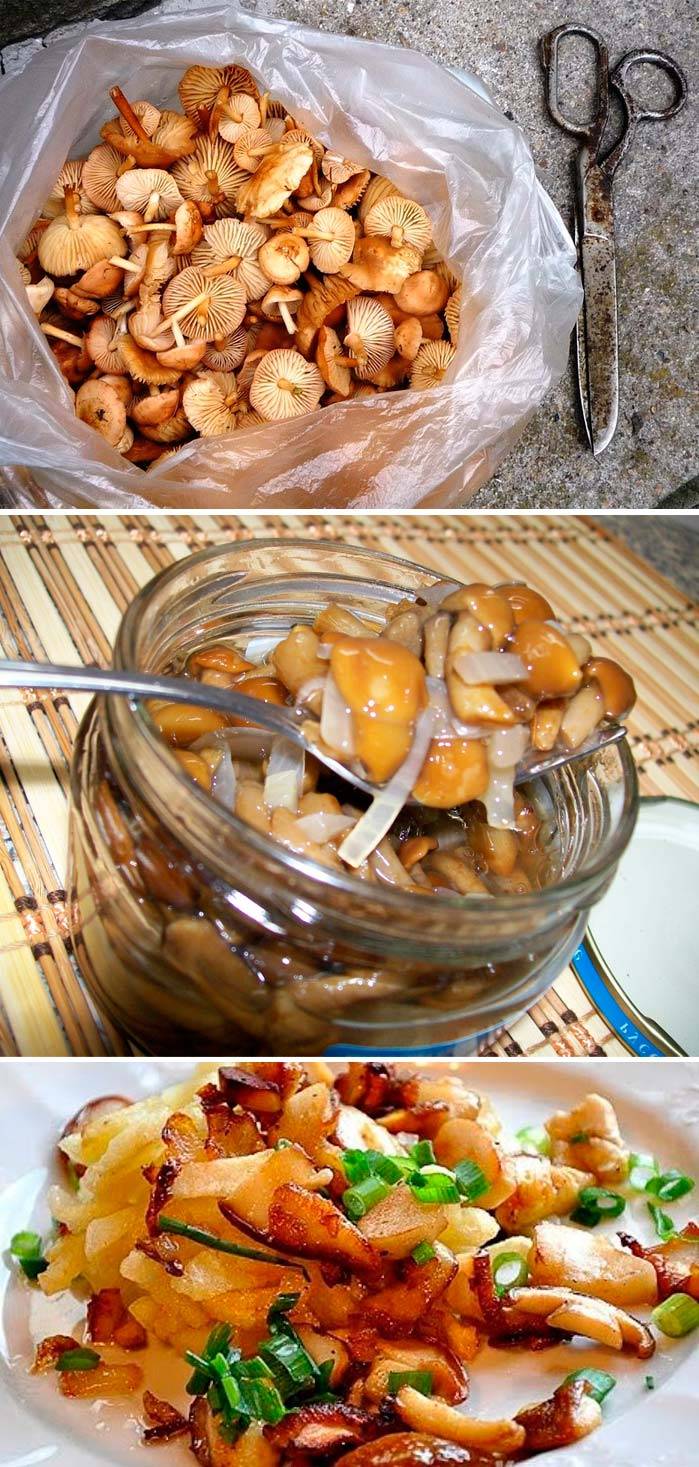If in the grass you see yellow caps of small mushrooms, do not rush to abandon them, mistaking them for toadstools. So that you know how not to miss a tasty and healthy mushroom, you need to stock up on some knowledge.
Meadow mushrooms belong to the Negniychnikovs. In Latin, their name sounds Marasmius oreades. In Russian, this means meadow non-nipple. They called him that because the mushroom does not rot, but dries up at the base. Even completely dry honey fungus gives spores when wet. It also has other names: marasmius, clove due to its persistent spicy smell.
Description of meadow mushrooms
The cap reaches 70 mm in circumference. In a newly appeared mushroom, it is spherical with a tubercle in the middle. With aging, it becomes flat or bowl-shaped, but the elevation in the middle remains. Colored in a chocolate tone with a yellowish or scarlet tint. The perimeter with irregularities in the rib, with humidity, begin to shine through, the cap becomes sticky.
Slender and elongated leg (up to 100 mm). It can be the same shade as the hat or a little lighter. Food is not consumed because it is tough. The ring characteristic of honey agarics is absent, tk. they belong to different families (the common ones are referred to as the Stropharievs).
The plates are infrequent and widened. They change shade due to weather conditions: in rainy ones - ocher colors, in hot weather - snow-white or beige. In young specimens, they adhere to the leg, in strongly mature specimens, they exfoliate.
The pulp is yellowish, after harvesting it does not change its tone. The aroma is sweet-spicy, with clove and almond notes.
They have a distinctive feature - they glow in the dark.
When, where and how meadow mushrooms grow
Meadow (field) mushrooms do not grow on stumps, but on the ground. They prefer pastures, forest edges, etc. They are collected among thickets of grass, between trees and bushes, on paths in the forest or in the garden.
Do not occur singly. As a rule, they form groups, growing in rows. In the glades, families can be found forming a ring of about 0.8 m in circumference. This phenomenon is called the witch's circle.
They grow in damp but warm weather. For example, if it rained in May, then meadow mushrooms are harvested at the beginning of summer. If weather conditions permit, non-nippers will crawl out of the ground from June until the first frost. Honey mushrooms grow quickly, but die off in a short time, so you need to carefully select the time of collection.
Collecting them is a pleasure, just take scissors with you and cut off some of the caps at once, especially for drying.
Dangerous doubles, the difference between edible and false
But do not confuse meadow mushrooms with:
- forest-loving collibia;
- oily collibia;
- whitish talker;
- fiberglass.
The first twin mushroom also belongs to the Negniychnikovs. The wood-loving colibia is popularly called the spring or forest honeycomb, because it looks like a harmless fellow. If you accidentally confuse these two mushrooms, nothing bad will happen. The double is conditionally edible, that is, it can be eaten after cooking. However, its value is small: the hat is small, the taste and aroma are absent.
Collibia oily (oily) looks like a wood-loving one, but her hat has a larger circumference. Has no smell and taste.
Both collisions can be distinguished by the bulge in the middle. In doubles, it is absent or protrudes slightly. The plates in false mushrooms are frequent, in old ones - with reddish blotches. You can also tell them apart by their smell. In colibia, it is absent or gives off moist soil with an admixture of mustiness. Meadow mushroom has a pronounced aroma of spice.
Among the talkers there are false, conditionally edible, and edible varieties. There are about 250 species in total. Poisonous varieties pose a serious danger if eaten in place of the edible mushroom. Symptoms of intoxication appear after 30-40 minutes.It is expressed by confusion of thoughts, light-headedness, pain in the abdomen.
Even edible govorushki varieties can be dangerous when mixed with alcoholic beverages. They contain a substance that, when mixed with alcohol, causes increased sweating, tachycardia, flushing, weakness. In severe poisoning, fainting or even death is possible.
Meadow mushrooms with whitish talkers, as a rule, are confused by inexperienced mushroom pickers. Because the doppelganger grows next to the non-nippers. However, distinguishing one mushroom from another is quite simple: the false cap is white, its edges are even and tucked inward.
Honey mushrooms are less often confused with fiber mushrooms, because they are visually different. The double has a gray plate that turns brown over time. All its varieties are poisonous (over 100). Intoxication occurs quickly, the central nervous system is affected.
Differences between false mushrooms and honey agarics:
- more elongated leg;
- repulsive smell;
- wrong shade of hats;
- grayish, brownish or greenish plates.
If suddenly poisoning with an inedible mushroom occurs, the victim needs qualified medical assistance, so you need to call an ambulance team. While she is waiting, rinse the poisoned stomach. This can be done by giving a large amount of boiled water to drink. No tablets other than sorbents (for example, activated carbon) can be given on their own.
Useful properties of meadow mushrooms and their application
Hats are a great addition to dishes because they have an excellent aroma. Also, broth is cooked from them, it tastes even better than from the king of mushrooms (white).
Meadow mushrooms are used in the preparation of various sauces. And also for pickling, drying, snacks. For the dishes to work out, it is very important to know the rules for cleaning and preparing mushrooms.
Mushroom cleaning rules
Marasmius oreades dry out quickly and need to be cleaned faster after harvesting. Before the process, select only good specimens, discard old, moldy, dry, rotting ones.
Wash thoroughly, because under their caps there may be dirt, debris, bugs, etc. In addition, edible and poisonous specimens grow in close proximity to each other. Particles from dangerous can get on honey mushrooms.
If the mushrooms are dried, you do not need to wash them. It is enough to clean the place under the cap with a knife, cut off dry and moldy areas.
Cleaning before pickling:
- After harvesting, soak the mushrooms for 20-30 minutes in water warmed to room temperature.
- Remove the hard legs.
- Carefully remove the film from above with a knife, taking care not to damage the hat itself.
- You can leave the film on the inside or put the mushroom under running water to rinse it off.
- Rinse the caps well.
After cleansing, proceed to the next step.
Cooking features
Before using mushrooms, they must be pre-cooked. The cooking time depends on what will happen to the mushrooms next:
Frying and stewing... Boil for an hour in salted water. This happens in 2 stages. First, the mushrooms are simply boiled for 20 minutes. Then add onion, lavrushka and other spices, keep on the stove for another 40 minutes. Before further cooking, take it out of the water and dry it a little.
Freezing... It usually takes about an hour to cook. First, cook for 20 minutes, then drain the water, pour boiling water and keep on fire until tender.
Marinovka... Cook for 60-80 minutes so that the mushrooms are fully cooked. The old water is drained and boiled water is poured, salt and spices are added.
Cooking dried mushrooms... In order for the mushroom to regain its shape, it is brought to a boil in salted water. This takes about half an hour.
Boiled honey mushrooms are fried in a preheated pan for half an hour. If meat ingredients or potatoes are added, the time is increased to 40 minutes. There is no need to defrost frozen mushrooms.
It is easy to understand that such mushrooms are ready. They start shooting.
If the mushrooms are not pre-boiled, the frying time is increased to 40 minutes. Before that, they need to be kept in warm water for half an hour.
Other areas of application
Non-ironies have found their application in alternative medicine.A tincture is prepared from them, which contains a lot of marasmic acid. This substance helps to destroy many pathogenic microorganisms, incl. and Staphylococcus aureus.
However, the therapeutic effect has not been clinically proven; self-medication can lead to undesirable consequences. Therefore, before using the alternative method, you must consult a doctor. In addition, unconventional treatment methods can only alleviate the symptoms, but not cure the disease. This requires complex therapy.
Previously, girls collected hats of meadow mushrooms on a full moon. They applied them to the face, believing that mushrooms remove freckles, relieve inflammation, even out skin tone and improve its elasticity.










